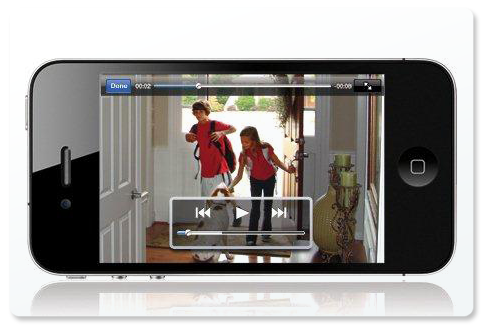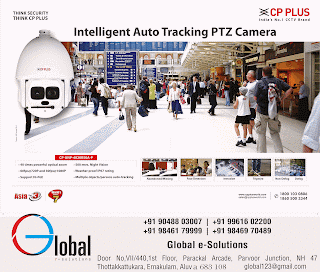Video systems: delivering value to enterprise business intelligence
 |
 If you think of video surveillance as an instrument of the security department, you risk overlooking the broader benefits of video. The fact is, video is much more than a security tool, it is a business intelligence (BI) tool. In this article, Gadi Piran President of OnSSI discusses how video systems can be used as an effective BI tool in a range of different vertical markets. The advances in video management systems that include cutting-edge video analytics present a huge opportunity for organizations to use such systems to boost business and consequently deliver greater ROI with a direct impact on the bottom line, he says.
If you think of video surveillance as an instrument of the security department, you risk overlooking the broader benefits of video. The fact is, video is much more than a security tool, it is a business intelligence (BI) tool. In this article, Gadi Piran President of OnSSI discusses how video systems can be used as an effective BI tool in a range of different vertical markets. The advances in video management systems that include cutting-edge video analytics present a huge opportunity for organizations to use such systems to boost business and consequently deliver greater ROI with a direct impact on the bottom line, he says.  The applications of surveillance video are manifold and way beyond the traditional core purpose of security. For example, video can help with process control, personnel management, inventory tracking, quality control, customer service or merchandising. Video can determine the most efficient scheduling of personnel or the most effective sales display. It can streamline manufacturing processes by providing an alert if there is a malfunction. Integrated with the HVAC system, video can even save energy costs by, for example, turning up the air conditioner only when room occupancy reaches a certain number.
The applications of surveillance video are manifold and way beyond the traditional core purpose of security. For example, video can help with process control, personnel management, inventory tracking, quality control, customer service or merchandising. Video can determine the most efficient scheduling of personnel or the most effective sales display. It can streamline manufacturing processes by providing an alert if there is a malfunction. Integrated with the HVAC system, video can even save energy costs by, for example, turning up the air conditioner only when room occupancy reaches a certain number.
Vertical market opportunities
In the world of IP-based systems, video is data and its value is unprecedented. Users can view manufacturing processes, monitor remote facilities, or even follow the migration of fish for scientific research. Video surveillance software facilitates remote monitoring of any location, even from a mobile device. Video management systems deliver video data in user-friendly formats that enable immediate response. Video surveillance solutions can work alone to deliver this intelligence or integrate with other business systems and optimize operations for access control, point of sale, teleconferencing, process control systems or anything on the enterprise network.
 |
| Video can facilitate personnel management and improve customer service at toll booths |
There are virtually limitless vertical markets where video offers value beyond the security department. A partial list would include the following:
Education
Network cameras can be located throughout a campus and can help administrators manage discipline problems or view facility usage. Video can help to manage the flow of students during recess, analyze bottlenecks that form between classes or view traffic flow as parents drop students off in the morning. In case of a maintenance problem, video can allow the central office to identify and observe the problem remotely before sending staff. Video can track facility occupancy, especially during the weekend or off-hours.
Transportation
 Expansive geography and large camera counts make video management systems especially useful tools in the transportation sector. For example, video can provide real-time views of toll booths to facilitate personnel management and improve customer service. Incorporating video and license-plate recognition functionality with toll payment systems can supply data tied to each transaction. Traffic cameras installed along highways can provide real-time traffic information, with a single software interface providing access to various camera views. A single interface can also provide views of various transportation facilities, offering additional benefits related to facility maintenance and personnel. Transportation applications also extend to ports and airports. Although security drives these markets, video also provides opportunities to improve operations and efficiencies at ports and airports.
Expansive geography and large camera counts make video management systems especially useful tools in the transportation sector. For example, video can provide real-time views of toll booths to facilitate personnel management and improve customer service. Incorporating video and license-plate recognition functionality with toll payment systems can supply data tied to each transaction. Traffic cameras installed along highways can provide real-time traffic information, with a single software interface providing access to various camera views. A single interface can also provide views of various transportation facilities, offering additional benefits related to facility maintenance and personnel. Transportation applications also extend to ports and airports. Although security drives these markets, video also provides opportunities to improve operations and efficiencies at ports and airports.
Public safety
 Video is valuable for crime prevention, but it also can play a positive and proactive community relations role. The presence of video cameras can help convert crime-prone neighborhoods into centers of commerce; it can transform abandoned city parks into places where families and children are safe to linger. Cameras located inside businesses, schools or other institutions can be networked into public safety systems to enable police, law enforcement or homeland security personnel to monitor emergency situations and the public safety response. Video can also assist with crowd control during special events to determine where more police officers are needed.
Video is valuable for crime prevention, but it also can play a positive and proactive community relations role. The presence of video cameras can help convert crime-prone neighborhoods into centers of commerce; it can transform abandoned city parks into places where families and children are safe to linger. Cameras located inside businesses, schools or other institutions can be networked into public safety systems to enable police, law enforcement or homeland security personnel to monitor emergency situations and the public safety response. Video can also assist with crowd control during special events to determine where more police officers are needed.
There is an opportunity gap between the immense capabilities of video systems and how they are currently being used in the customer base |
Healthcare
Video is available from cameras anywhere in a healthcare setting via a campus-wide network or the Internet. Any computer can access video, so hospital management and department heads can immediately see what is happening in real-time. Mobile access to video even allows remote monitoring of activity across the hospital.
Retail
Beyond the obvious functions of security and loss prevention, surveillance video can help determine the most effective scheduling of personnel or the most effective point-of-purchase (POP) display by viewing when the busiest times are in stores or at a particular counter or display. By analyzing video, retailers can determine customer spending habits and the best use of personnel.
Utilities
When any remote element of a utility's operation has a problem, camera views of the situation can guide operators to a timely and appropriate response. Operational benefits make video cameras even more valuable in an environment where protection of critical infrastructure is paramount.
Video management systems make it possible
The advancement in video management capabilities is driven to a great extent by the shift to open architecture. Collaboration with third-party vendors helps to extend the core benefits and functionality of video management software to include cutting-edge technologies, such as video analytics, and to expand networks using wireless mesh and broadband networks.
 |
| Surveillance cameras can help transform abandoned city parks into places where families and children into safer areas |
Video management systems are also becoming easier to use, and even large systems can now be managed effectively and efficiently. Customers need real-time business intelligence to be presented in a usable format. Increasing number of video cameras and size of these systems are creating the real possibility of “information overload” for operators. To enable users to cope, video systems can tie the various information strands together. More importantly, the systems can be customized so that the user gets only the information he or she needs – and gets it when, where and how it is needed. Better information enables better decision-making and faster reactions. User interfaces are less complicated and include only information that is pertinent. Operating such a system is so intuitive as to become second-nature.
Video management systems and the opportunity gap
There is an opportunity gap between the immense capabilities of video systems and how they are currently being used in the customer base. One element in the gap is the need to educate a broader range of end-users about the value of video beyond the security department, the core customer who has historically been at the center of a video system purchase.
Video systems can provide a new and effective management device useful throughout today’s companies. This exciting, untapped potential also relates to another challenge in the current economic environment, which is the need to show a return on investment (ROI) for any technology purchase. The value proposition for video as a security and surveillance tool may be well understood in our industry, but economics make it imperative that the bottom-line benefit also be communicated effectively to the customer. The added value of uncovering additional benefits and uses of video makes the ROI case even stronger.
Security and business intelligence both have the same objective, which is to improve the bottom line. To that end, using a video system to provide data that transcends physical protection to boost operations and business efficiency makes perfect sense


Comments
Post a Comment